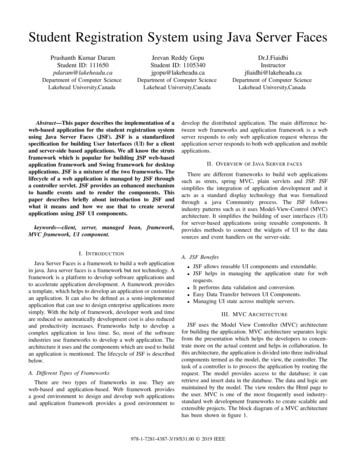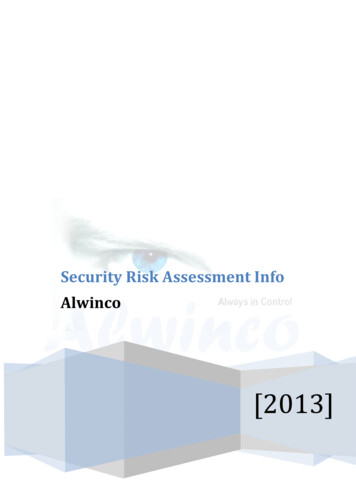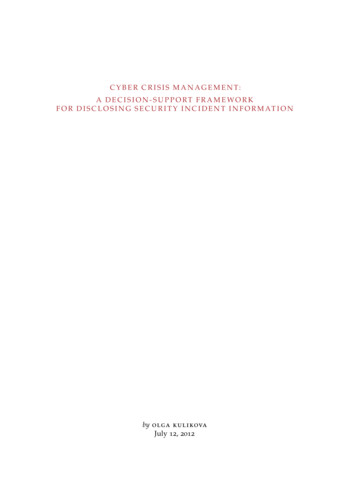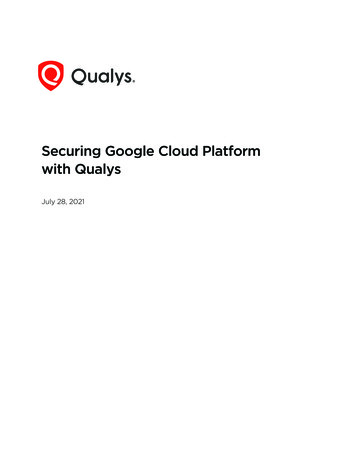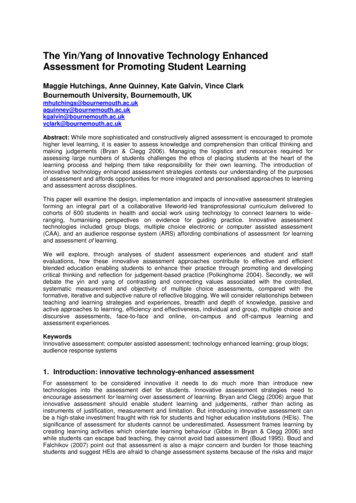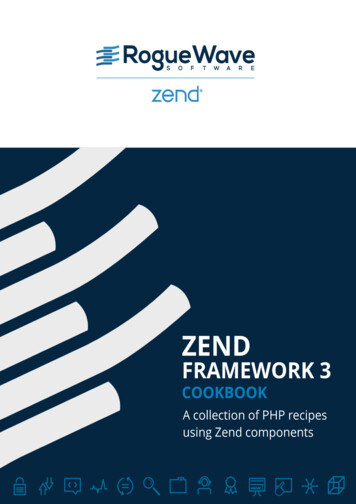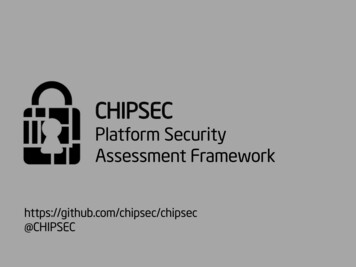
Transcription
CHIPSECPlatform SecurityAssessment C
What is Platform Security?Hardware Implementation and Configuration Available Security Features Correct Configuration of HW Components Testing/Demonstration of HW Security MechanismsFirmware Implementation and Configuration Access Controls on Firmware Interfaces Correct Settings of Lock Bits Testing/Demonstration of FW Security Mechanisms
Example: System Management ModeCanSecWest 2006 “Security Issues Related to Pentium SystemManagement Mode” – DuflotIs Compatible SMRAM Protected?“Attacking SMM Memory via Intel CPU Cache Poisoning” – Wojtczuk,Rutkowska“Getting into the SMRAM: SMM Reloaded” – Duflot, Levillain, Morin,GrumelardIs SMRAM Vulnerable to Cache Poisoning Attack?
Example: BIOS Write ProtectionPersistent BIOS Infection – Sacco, OrtegaCanSecWest 2013 “Evil Maid Just Got Angrier” – BulyginBlack Hat USA 2013 “BIOS Security” – Butterworth, Kallenberg, Kovah“BIOS Chronomancy: Fixing the Core Root of Trust for Measurement”– Butterworth, Kallenberg, KovahBlackHat USA 2013 “A Tale Of One Software Bypass Of Windows 8Secure Boot” – Bulygin, Furtak, BazhaniukIs BIOS Protected in SPI Flash?
Motivating Platform Security Assessment Security Issues Related to Pentium System Management Mode (CSW 2006)Implementing and Detecting an ACPI BIOS Rootkit (BlackHat EU 2006)Implementing and Detecting a PCI Rootkit (BlackHat DC 2007)Programmed I/O accesses: a threat to Virtual Machine Monitors? (PacSec 2007)Hacking the Extensible Firmware Interface (BlackHat USA 2007)BIOS Boot Hijacking And VMWare Vulnerabilities Digging (PoC 2007)Bypassing pre-boot authentication passwords (DEF CON 16)Using SMM for "Other Purposes“ (Phrack65)Persistent BIOS Infection (Phrack66)A New Breed of Malware: The SMM Rootkit (BlackHat USA 2008)Preventing & Detecting Xen Hypervisor Subversions (BlackHat USA 2008)A Real SMM Rootkit: Reversing and Hooking BIOS SMI Handlers (Phrack66)Attacking Intel BIOS (BlackHat USA 2009)Getting Into the SMRAM: SMM Reloaded (CSW 2009, CSW 2009)Attacking SMM Memory via Intel Cache Poisoning (ITL 2009)BIOS SMM Privilege Escalation Vulnerabilities (bugtraq 2009)System Management Mode Design and Security Issues (IT Defense 2010)Analysis of building blocks and attack vectors associated with UEFI (SANS Institute)(U)EFI Bootkits (BlackHat USA 2012 @snare, SaferBytes 2012 Andrea Allievi, HITB 2013)Evil Maid Just Got Angrier: Why Full-Disk Encryption With TPM Is Insecure On Many Systems (CSW 2013)A Tale of One Software Bypass of Windows 8 Secure Boot (BlackHat USA 2013)BIOS Chronomancy (NoSuchCon 2013, BlackHat USA 2013, Hack.lu 2013)Defeating Signed BIOS Enforcement (PacSec 2013, Ekoparty 2013)UEFI and PCI BootKit (PacSec 2013)Meet „badBIOS‟ the mysterious Mac and PC malware that jumps airgaps (#badBios)All Your Boot Are Belong To Us (CanSecWest 2014 Intel and MITRE)Setup for Failure: Defeating Secure Boot (Syscan 2014)Setup for Failure: More Ways to Defeat Secure Boot (HITB 2014 AMS)Analytics, and Scalability, and UEFI Exploitation (INFILTRATE 2014)PC Firmware Attacks, Copernicus and You (AusCERT 2014)Extreme Privilege Escalation (BlackHat USA 2014)Summary of Attacks Against BIOS and Secure Boot (DEF CON 22)
When Is Secure Boot Actually Secure?When all platform manufacturers
When Is Secure Boot Actually Secure?When all platform manufacturers protect the UEFI BIOS from programmable SPI writes by malware,allow only signed UEFI BIOS updates,protect authorized update software,correctly program and protect SPI Flash descriptor,protect Secure Boot persistent configuration variables in NVRAM,implement authenticated variable updates,protect variable update API,disable Compatibility Support Module,don‟t allow unsigned legacy Option ROMs,configure secure image verification policies,don‟t reinvent image verification functionality,
When Is Secure Boot Actually Secure?When all platform manufacturers protect the UEFI BIOS from programmable SPI writes by malware, allow only signed UEFI BIOS updates, protect authorized update software, correctly program and protect SPI Flash descriptor, protect Secure Boot persistent configuration variables in NVRAM, implement authenticated variable updates, protect variable update API, disable Compatibility Support Module, don‟t allow unsigned legacy Option ROMs, configure secure image verification policies, don‟t reinvent image verification functionality, and don’t introduce a single bug in all of this, of course.
Introduction to CHIPSEC
How do we raise the bar?Empowering End-Users to Make a Risk Decision
*Other names and brands may be claimed as the property of others.
Known Threats and CHIPSEC modulesIssueCHIPSEC ModuleReferencesSMRAM Lockingcommon.smmCanSecWest 2006BIOS Keyboard Buffer Sanitizationcommon.bios kbrd bufferDEFCON 16 2008SMRR Configurationcommon.smrrITL 2009CanSecWest 2009BIOS Protectioncommon.bios wpBlackHat USA 2009CanSecWest 2013Black Hat 2013NoSuchCon 2013FlashromSPI Controller Lockingcommon.spi lockFlashromCopernicusBIOS Interface Lockingcommon.bios tsPoC 2007Access Control for Secure Boot Keyscommon.secureboot.keysUEFI 2.4 SpecAccess Control for Secure BootVariablescommon.secureboot.variablesUEFI 2.4 Spec
Example: System Management ModeIs SMRAM Vulnerable to Cache Poisoning Attack?common.smrr[ ] imported chipsec.modules.common.smrr[x][ [x][ Module: CPU SMM Cache Poisoning / SMM Range Registers (SMRR)[x][ [ ] OK. SMRR are supported in IA32 MTRRCAP MSR [ ] OK so far. SMRR Base is programmed [ ] OK so far. SMRR are enabled in SMRR MASK MSR [ ] OK so far. SMRR MSRs match on all CPUs[ ] PASSED: SMRR protection against cache attack seems properlyconfigured
Example: System Management ModeIs Compatibility SMRAM Protected?common.smm[ ] imported chipsec.modules.common.smm[x][ [x][ Module: SMM memory (SMRAM) Lock[x][ [*] SMRAM register 0x1A ( D LCK 1, D OPEN 0 )[ ] PASSED: SMRAM is locked
Example: BIOS Write ProtectionIs BIOS Protected in SPI Flash?common.bios wp[ ] imported chipsec.modules.common.bios wp[x][ [x][ Module: BIOS Region Write Protection[x][ BIOS Control (BDF 0:31:0 0xDC) 0x2A[05]SMM BWP 1 (SMM BIOS Write Protection)[04]TSS 0 (Top Swap Status)[01]BLE 1 (BIOS Lock Enable)[00]BIOSWE 0 (BIOS Write Enable)[ ] BIOS region write protection is enabled (writes restricted to SMM)[*] BIOS Region: Base 0x00500000, Limit 0x00FFFFFFSPI Protected ---------------PRx (offset) Value Base Limit WP? ------------PR0 (74) 00000000 00000000 00000000 0 0PR1 (78) 8FFF0F40 00F40000 00FFF000 1 0PR2 (7C) 8EDF0EB1 00EB1000 00EDF000 1 0PR3 (80) 8EB00EB0 00EB0000 00EB0000 1 0PR4 (84) 8EAF0C00 00C00000 00EAF000 1 0[!] SPI protected ranges write-protect parts of BIOS region (other parts ofBIOS can be modified)[ ] PASSED: BIOS is write protected
Structurechipsec main.py runs modules (see modules dir below)chipsec util.py runs manual utilities (see utilcmd dir below)/chipsec/cfgplatform specific configuration/halall the HW stuff you can interact with/helpersupport for OS/environments/modulesmodules (tests/tools/PoCs) go here/utilcmdutility commands for chipsec util
Writing a Module Exampledef check spi lock(self):self.logger.start test( "SPI Flash Controller Configuration Lock" )Defined in HALspi locked 0hsfsts reg value self.spi.spi reg read( SPI HSFSTS OFFSET).if 0 ! (hsfsts reg value & SPI HSFSTS FLOCKDN MASK):spi locked 1self.logger.log passed check( "SPI Flash Controller configuration is locked" )else:self.logger.log failed check( "SPI Flash Controller configuration is not locked" )return spi locked 1def run( self, module argv ):return self.check spi lock()Module Starts Here
Manual Analysis and Forensics
BIOS/Firmware ForensicsLive system firmware analysischipsec util spi infochipsec util spi dump rom.binchipsec util spi read 0x700000 0x100000 bios.binchipsec util uefi var-listchipsec util uefi var-read dbD719B2CB-3D3A-4596-A3BC-DAD00E67656F db.binOffline system firmware analysischipsec util uefi keys PK.binchipsec util uefi nvram vss bios.binchipsec util uefi decode rom.binchipsec util decode rom.bin
Manual Access to HW Resourceschipsec util msr 0x200chipsec util mem 0x0 0x41E 0x20chipsec util pci enumeratechipsec util pci 0x0 0x1F 0x0 0xDC bytechipsec util io 0x61 bytechipsec util mmcfg 0 0x1F 0 0xDC 1 0x1chipsec util mmio listchipsec util cmos dumpchipsec util ucode idchipsec util smi 0x01 0xFFchipsec util idt 0chipsec util cpuid 1chipsec util spi read 0x700000 0x100000 bios.binchipsec util decode spi.binchipsec util uefi var-list.
Motivating Platform Security Assessment Security Issues Related to Pentium System Management Mode (CSW 2006) Implementing and Detecting an ACPI BIOS Rootkit (BlackHat EU 2006) Implementing and Detecting a PCI Rootkit (BlackHat DC 2007) Programmed I/O accesses: a threat to Virtual Machine Monitors? (PacSec 2007)
